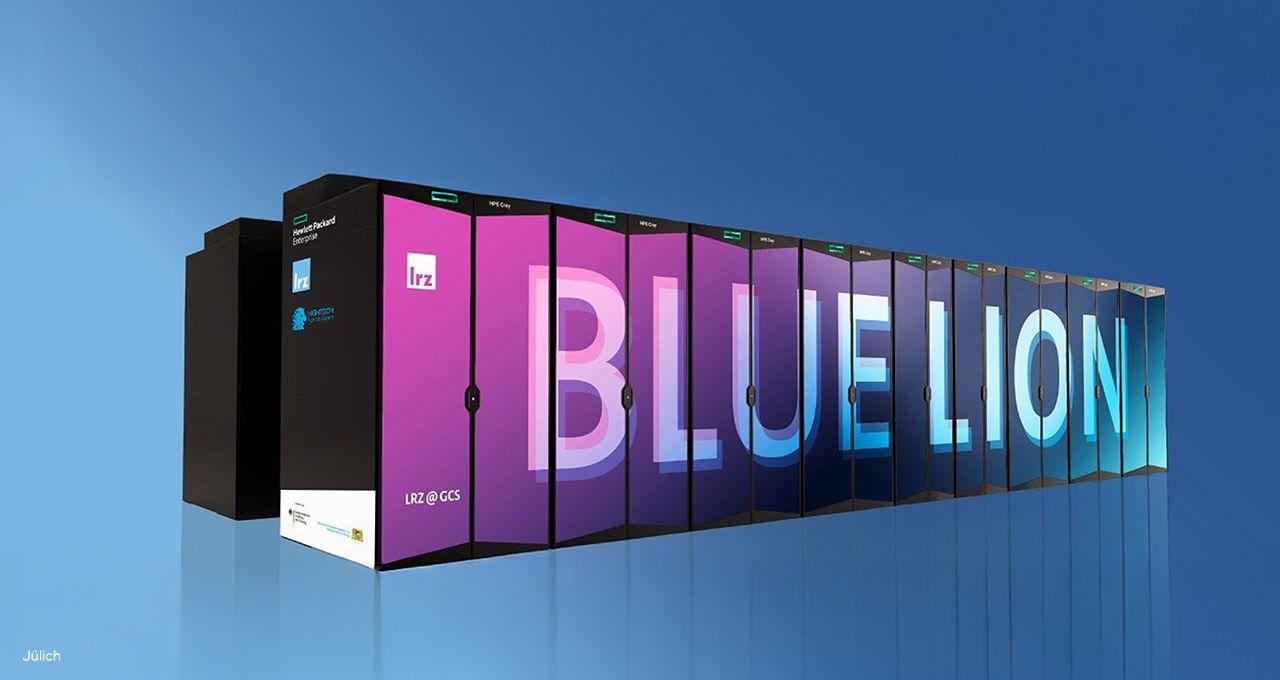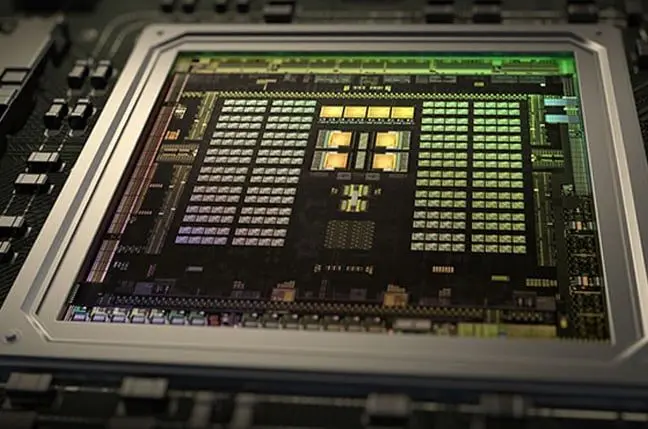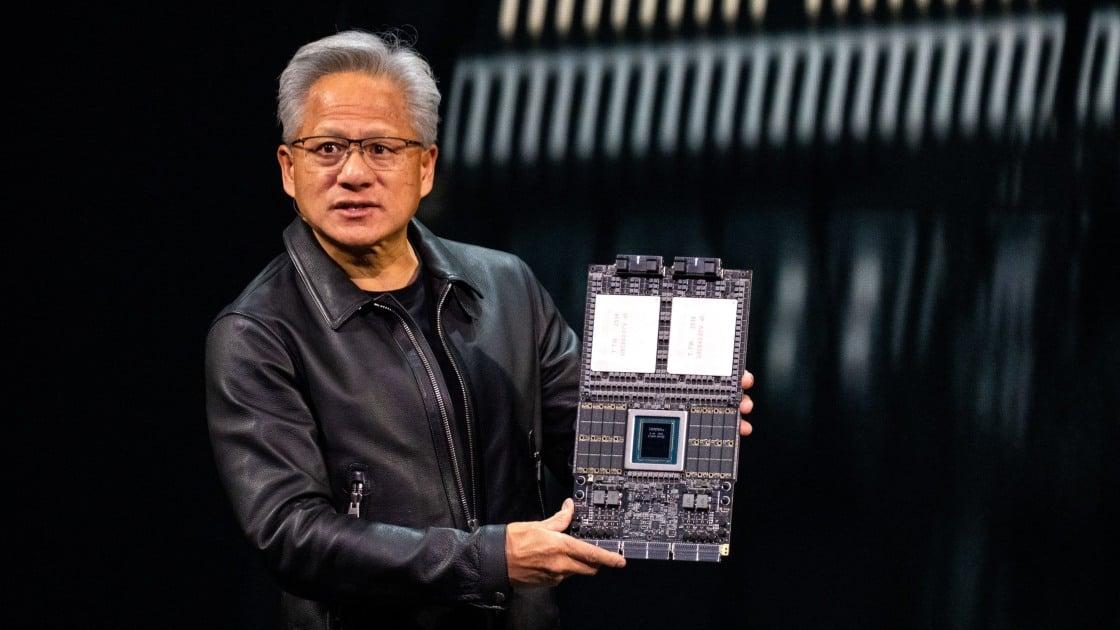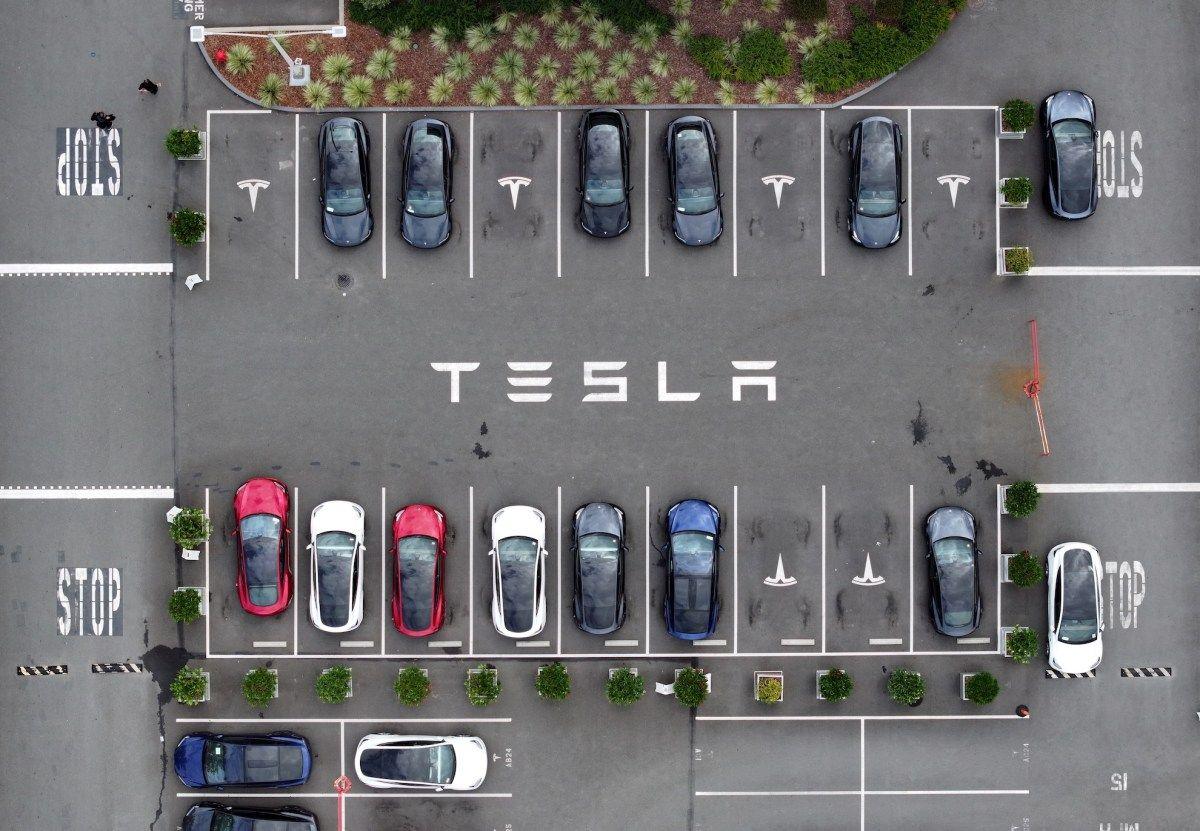Nvidia and HPE to Build Blue Lion Supercomputer in Germany, Powered by Next-Gen Vera Rubin Architecture
6 Sources
6 Sources
[1]
Nvidia, HPE to build new supercomputer in Germany
SAN FRANCISCO, June 10 (Reuters) - Nvidia (NVDA.O), opens new tab and Hewlett Packard Enterprise (HPE.N), opens new tab said on Tuesday they are partnering with the Leibniz Supercomputing Centre to build a new supercomputer using Nvidia's next-generation chips. The Blue Lion supercomputer, as the project is called, will become available to scientists in early 2027, using Nvidia's "Vera Rubin" chips. The announcement, made at a supercomputing conference in Hamburg, Germany, follows Nvidia's announcement that the Lawrence Berkeley National Lab in the United States also plans to build a system using the chips next year. Separately, Nvidia also said that Jupiter, another supercomputer using its chips at German national research institute Forschungszentrum Julich, has officially become Europe's fastest system. The deals represent European institutions aiming to stay competitive against the U.S. in supercomputers used for scientific fields from biotechnology to climate research. Long before it became an artificial intelligence powerhouse, Nvidia set out to persuade scientists to use its chips to speed up complex computer problems, such as modeling climate change. Those problems required many precise calculations that could take months at a time. Nvidia is now working to persuade scientists to use artificial intelligence. Those AI systems can take the results of a few precise calculations and use them to make predictions that, while not as accurate as the fully calculated results, can still be useful while taking far less time. Nvidia on Tuesday unveiled what it calls its "Climate in a Bottle" AI model. In a press briefing, Dion Harris, head of data center product marketing at Nvidia, said scientists will be able to input a few initial conditions such as sea surface temperatures and generate a forecast for 10 to 30 years in the future and see what the weather may be like at any kilometer or so of the earth's surface. "Researchers will use combined approach of classic physics and AI to resolve turbulent atmospheric flows," Harris said. "This technique will allow them to analyze thousands and thousands more scenarios in greater detail than ever before." Reporting by Stephen Nellis in San Francisco; Editing by Lincoln Feast. Our Standards: The Thomson Reuters Trust Principles., opens new tab Suggested Topics:Artificial IntelligenceClimate ChangeClimate Solutions
[2]
The Blue Lion Supercomputer Will Run on NVIDIA Vera Rubin -- Here's Why That Matters
Two new supercomputers. One new architecture. Vera Rubin is built to change how science gets done -- in real time, at massive scale. Germany's Leibniz Supercomputing Centre, LRZ, is gaining a new supercomputer that delivers roughly 30x more computing power compared with SuperMUC-NG, the current LRZ high-performance computer. It's called Blue Lion. And it will run on the NVIDIA Vera Rubin architecture. That's new. Until now, LRZ -- part of the Gauss Centre for Supercomputing, Germany's leading HPC institution -- had only said its next system would use "next-generation" NVIDIA accelerators and processors. We're confirming it: That next generation is Vera Rubin, NVIDIA's upcoming platform for AI and accelerated science. If the name sounds familiar, it should. Last month, Lawrence Berkeley National Lab unveiled Doudna, its next flagship system that will also be powered by Vera Rubin. Together, they form a platform built to collapse simulation, data and AI into a single, high-bandwidth, low-latency engine for science. It combines shared memory, coherent compute and in-network acceleration -- and is launching in the second half of 2026. Blue Lion is built to meet it. HPE is building Blue Lion. It will use next-generation HPE Cray technology and feature NVIDIA GPUs in a system equipped with powerful storage and interconnect that harnesses HPE's 100% fanless direct liquid-cooling systems architecture, which uses warm water delivered through pipes to efficiently cool the supercomputer. It's built for researchers working on climate, turbulence, physics and machine learning, with workflows that blend classic simulation and modern AI. Jobs can scale across the entire system. Heat from the racks will be reused to warm nearby buildings. And it's not just local. Blue Lion will support collaborative research projects across Europe. Meanwhile, in Berkeley, California, Doudna, the U.S. Department of Energy's next supercomputer, will also run Vera Rubin. Built by Dell Technologies, the supercomputer is named for Nobel laureate and CRISPR pioneer Jennifer Doudna and will serve over 11,000 researchers when it launches next year. Doudna will be wired for real-time workflows and optimized for science results per joule of energy. Data streams in from telescopes, genome sequencers and fusion experiments and lands directly in the system via NVIDIA Quantum-X800 InfiniBand networking. Processing starts instantly. Feedback loops are live. It's designed to advance fusion energy, materials discovery and biology faster. Compared with its predecessor, it's expected to deliver 10x more application performance, using just 2-3x the power. That's 3-5x better performance per watt. Blue Lion and Doudna aren't just big machines. They're signals of what comes next: a shift in how high-performance systems are designed, used and connected. AI is no longer an add-on. Simulation isn't a silo. Data isn't parked -- it moves. Science is becoming a real-time discipline. The systems that power it need to keep up.
[3]
The Blue Lion Supercomputer Will Run on NVIDIA Vera Rubin -- Here's Why That Matters
Two new supercomputers. One new architecture. Vera Rubin is built to change how science gets done -- in real time, at massive scale. Germany's Leibniz Supercomputing Centre, LRZ, is gaining a new supercomputer that delivers roughly 30x more computing power compared with SuperMUC-NG, the current LRZ high-performance computer. It's called Blue Lion. And it will run on the NVIDIA Vera Rubin architecture. That's new. Until now, LRZ -- part of the Gauss Centre for Supercomputing, Germany's leading HPC institution -- had only said its next system would use "next-generation" NVIDIA accelerators and processors. We're confirming it: That next generation is Vera Rubin, NVIDIA's upcoming platform for AI and accelerated science. If the name sounds familiar, it should. Last month, Lawrence Berkeley National Lab unveiled Doudna, its next flagship system that will also be powered by Vera Rubin. Together, they form a platform built to collapse simulation, data and AI into a single, high-bandwidth, low-latency engine for science. It combines shared memory, coherent compute and in-network acceleration -- and is launching in the second half of 2026. HPE is building Blue Lion. It will use next-generation HPE Cray technology and feature NVIDIA GPUs in a system equipped with powerful storage and interconnect that harnesses HPE's 100% fanless direct liquid-cooling systems architecture, which uses warm water delivered through pipes to efficiently cool the supercomputer. It's built for researchers working on climate, turbulence, physics and machine learning, with workflows that blend classic simulation and modern AI. Jobs can scale across the entire system. Heat from the racks will be reused to warm nearby buildings. And it's not just local. Blue Lion will support collaborative research projects across Europe. About the Doudna Supercomputer Meanwhile, in Berkeley, California, Doudna, the U.S. Department of Energy's next supercomputer, will also run Vera Rubin. Built by Dell Technologies, the supercomputer is named for Nobel laureate and CRISPR pioneer Jennifer Doudna and will serve over 11,000 researchers when it launches next year. Doudna will be wired for real-time workflows and optimized for science results per joule of energy. Data streams in from telescopes, genome sequencers and fusion experiments and lands directly in the system via NVIDIA Quantum-X800 InfiniBand networking. Processing starts instantly. Feedback loops are live. It's designed to advance fusion energy, materials discovery and biology faster. Compared with its predecessor, it's expected to deliver 10x more application performance, using just 2-3x the power. That's 3-5x better performance per watt. Why This All Matters Blue Lion and Doudna aren't just big machines. They're signals of what comes next: a shift in how high-performance systems are designed, used and connected. AI is no longer an add-on. Simulation isn't a silo. Data isn't parked -- it moves. Science is becoming a real-time discipline. The systems that power it need to keep up.
[4]
Nvidia, HPE to build new supercomputer in Germany
Nvidia and HPE are building the "Blue Lion" supercomputer with Nvidia's "Vera Rubin" chips for the Leibniz Supercomputing Centre, available by early 2027. This boosts European scientific competitiveness against the U.S. and highlights Nvidia's expanded focus on AI for accelerated climate research, like its new "Climate in a Bottle" model.Nvidia and Hewlett Packard Enterprise said on Tuesday they are partnering with the Leibniz Supercomputing Centre to build a new supercomputer using Nvidia's next-generation chips. The Blue Lion supercomputer, as the project is called, will become available to scientists in early 2027, using Nvidia's "Vera Rubin" chips. The announcement, made at a supercomputing conference in Hamburg, Germany, follows Nvidia's announcement that the Lawrence Berkeley National Lab in the United States also plans to build a system using the chips next year. Separately, Nvidia also said that Jupiter, another supercomputer using its chips at German national research institute Forschungszentrum Julich, has officially become Europe's fastest system. The deals represent European institutions aiming to stay competitive against the U.S. in supercomputers used for scientific fields from biotechnology to climate research. Long before it became an artificial intelligence powerhouse, Nvidia set out to persuade scientists to use its chips to speed up complex computer problems, such as modeling climate change. Those problems required many precise calculations that could take months at a time. Nvidia is now working to persuade scientists to use artificial intelligence. Those AI systems can take the results of a few precise calculations and use them to make predictions that, while not as accurate as the fully calculated results, can still be useful while taking far less time. Nvidia on Tuesday unveiled what it calls its "Climate in a Bottle" AI model. In a press briefing, Dion Harris, head of data center product marketing at Nvidia, said scientists will be able to input a few initial conditions such as sea surface temperatures and generate a forecast for 10 to 30 years in the future and see what the weather may be like at any kilometer or so of the earth's surface. "Researchers will use combined approach of classic physics and AI to resolve turbulent atmospheric flows," Harris said. "This technique will allow them to analyze thousands and thousands more scenarios in greater detail than ever before."
[5]
Nvidia, HPE to build new supercomputer in Germany
SAN FRANCISCO -- Nvidia and Hewlett Packard Enterprise said on Tuesday they are partnering with the Leibniz Supercomputing Centre to build a new supercomputer using Nvidia's next-generation chips. The Blue Lion supercomputer, as the project is called, will become available to scientists in early 2027, using Nvidia's "Vera Rubin" chips. The announcement, made at a supercomputing conference in Hamburg, Germany, follows Nvidia's announcement that the Lawrence Berkeley National Lab in the United States also plans to build a system using the chips next year. Separately, Nvidia also said that Jupiter, another supercomputer using its chips at German national research institute Forschungszentrum Julich, has officially become Europe's fastest system. The deals represent European institutions aiming to stay competitive against the U.S. in supercomputers used for scientific fields from biotechnology to climate research. Long before it became an artificial intelligence powerhouse, Nvidia set out to persuade scientists to use its chips to speed up complex computer problems, such as modeling climate change. Those problems required many precise calculations that could take months at a time. Nvidia is now working to persuade scientists to use artificial intelligence. Those AI systems can take the results of a few precise calculations and use them to make predictions that, while not as accurate as the fully calculated results, can still be useful while taking far less time. Nvidia on Tuesday unveiled what it calls its "Climate in a Bottle" AI model. In a press briefing, Dion Harris, head of data center product marketing at Nvidia, said scientists will be able to input a few initial conditions such as sea surface temperatures and generate a forecast for 10 to 30 years in the future and see what the weather may be like at any kilometer or so of the earth's surface. "Researchers will use combined approach of classic physics and AI to resolve turbulent atmospheric flows," Harris said. "This technique will allow them to analyze thousands and thousands more scenarios in greater detail than ever before."
[6]
Nvidia, HPE to build new supercomputer in Germany
SAN FRANCISCO (Reuters) -Nvidia and Hewlett Packard Enterprise said on Tuesday they are partnering with the Leibniz Supercomputing Centre to build a new supercomputer using Nvidia's next-generation chips. The Blue Lion supercomputer, as the project is called, will become available to scientists in early 2027, using Nvidia's "Vera Rubin" chips. The announcement, made at a supercomputing conference in Hamburg, Germany, follows Nvidia's announcement that the Lawrence Berkeley National Lab in the United States also plans to build a system using the chips next year. Separately, Nvidia also said that Jupiter, another supercomputer using its chips at German national research institute Forschungszentrum Julich, has officially become Europe's fastest system. The deals represent European institutions aiming to stay competitive against the U.S. in supercomputers used for scientific fields from biotechnology to climate research. Long before it became an artificial intelligence powerhouse, Nvidia set out to persuade scientists to use its chips to speed up complex computer problems, such as modeling climate change. Those problems required many precise calculations that could take months at a time. Nvidia is now working to persuade scientists to use artificial intelligence. Those AI systems can take the results of a few precise calculations and use them to make predictions that, while not as accurate as the fully calculated results, can still be useful while taking far less time. Nvidia on Tuesday unveiled what it calls its "Climate in a Bottle" AI model. In a press briefing, Dion Harris, head of data center product marketing at Nvidia, said scientists will be able to input a few initial conditions such as sea surface temperatures and generate a forecast for 10 to 30 years in the future and see what the weather may be like at any kilometer or so of the earth's surface. "Researchers will use combined approach of classic physics and AI to resolve turbulent atmospheric flows," Harris said. "This technique will allow them to analyze thousands and thousands more scenarios in greater detail than ever before." (Reporting by Stephen Nellis in San Francisco; Editing by Lincoln Feast.)
Share
Share
Copy Link
Nvidia and HPE are partnering with the Leibniz Supercomputing Centre to build the Blue Lion supercomputer, featuring Nvidia's next-generation Vera Rubin chips. This collaboration aims to boost European scientific competitiveness and advance AI-driven research in climate modeling and other fields.
Nvidia and HPE Collaborate on Blue Lion Supercomputer
Nvidia and Hewlett Packard Enterprise (HPE) have announced a partnership with the Leibniz Supercomputing Centre (LRZ) to construct a new supercomputer named Blue Lion. This cutting-edge system will utilize Nvidia's next-generation "Vera Rubin" chips and is scheduled to be operational for scientists by early 2027
1
2
.
Source: ET
Blue Lion's Specifications and Capabilities
The Blue Lion supercomputer is designed to deliver approximately 30 times more computing power compared to LRZ's current high-performance computer, SuperMUC-NG. It will feature next-generation HPE Cray technology and Nvidia GPUs, incorporating HPE's 100% fanless direct liquid-cooling systems architecture for efficient cooling
3
.Blue Lion is tailored for researchers working on climate, turbulence, physics, and machine learning, with workflows that combine classic simulation and modern AI. The system will support job scaling across its entire infrastructure and utilize heat from its racks to warm nearby buildings
3
.Vera Rubin Architecture: A New Era in Scientific Computing

Source: NVIDIA
The Vera Rubin architecture, set to launch in the second half of 2026, represents a significant advancement in scientific computing. It aims to integrate simulation, data processing, and AI into a single, high-bandwidth, low-latency engine for science. This architecture combines shared memory, coherent compute, and in-network acceleration
3
.European Competitiveness in Supercomputing
The development of Blue Lion signifies a strategic move by European institutions to remain competitive with the United States in supercomputing capabilities. These advanced systems are crucial for various scientific fields, including biotechnology and climate research
1
4
.Nvidia's Expanding Role in Scientific Computing
Nvidia, known for its recent prominence in artificial intelligence, has a long-standing history of engaging scientists to utilize its chips for complex computational problems. The company is now advocating for the integration of AI in scientific research, proposing that AI systems can generate useful predictions based on limited precise calculations, significantly reducing processing time
1
5
.Related Stories
Climate in a Bottle: Nvidia's New AI Model
Alongside the Blue Lion announcement, Nvidia unveiled its "Climate in a Bottle" AI model. This innovative tool allows scientists to input initial conditions such as sea surface temperatures and generate long-term weather forecasts. Dion Harris, head of data center product marketing at Nvidia, explained that researchers can analyze thousands of scenarios in unprecedented detail, combining classic physics with AI to resolve turbulent atmospheric flows
1
5
.Global Impact and Future Prospects
The Blue Lion project is not limited to local research; it will support collaborative research initiatives across Europe. This development, along with other supercomputers like Doudna at Lawrence Berkeley National Lab and Jupiter at Forschungszentrum Julich, represents a shift in how high-performance systems are designed, used, and interconnected globally
3
4
.As science evolves into a real-time discipline, these advanced systems are poised to keep pace with the changing landscape of scientific research and data processing. The integration of AI, simulation, and data movement in these supercomputers marks a new era in scientific computing, promising faster and more efficient research outcomes across various fields
3
.References
Summarized by
Navi
Related Stories
Doudna Supercomputer: Dell and Nvidia Join Forces with DOE for Next-Gen AI-Powered Scientific Discovery
30 May 2025•Technology

NVIDIA Predicts AI-Accelerated Future for Scientific Computing as GPU Supercomputers Dominate Top500
18 Nov 2025•Science and Research

Nvidia Unveils Vera Rubin Superchip: Six-Trillion Transistor AI Platform Set for 2026 Production
29 Oct 2025•Technology

Recent Highlights
1
OpenAI releases GPT-5.2 AI model after code red memo targets Google's Gemini 3 threat
Technology

2
Disney invests $1 billion in OpenAI, licenses 200+ characters for Sora AI video generator
Technology

3
OpenAI faces wrongful death lawsuit after ChatGPT allegedly fueled murder-suicide tragedy
Policy and Regulation





